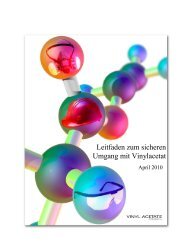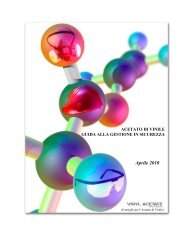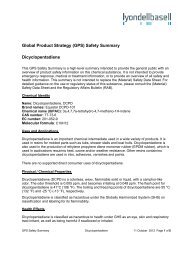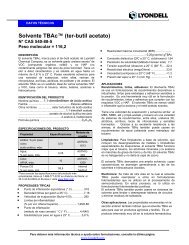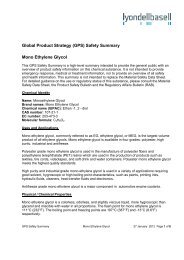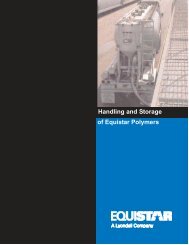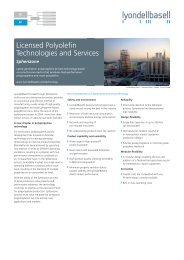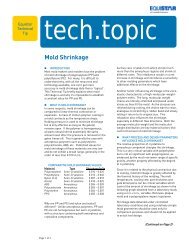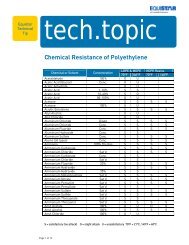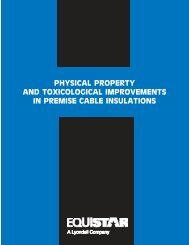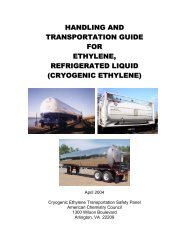Film Extrusion Guide.pmd - LyondellBasell
Film Extrusion Guide.pmd - LyondellBasell
Film Extrusion Guide.pmd - LyondellBasell
You also want an ePaper? Increase the reach of your titles
YUMPU automatically turns print PDFs into web optimized ePapers that Google loves.
are coextruded with resins of<br />
higher melting temperatures. EMAs<br />
offer better low temperature melting<br />
properties and good adhesion to a<br />
wide variety of substrates.<br />
Ethylene is the primary<br />
comonomer used with PP. PP<br />
random copolymers have<br />
propylene backbones containing<br />
random ethylene groups. Impact<br />
copolymers have propylene<br />
backbones containing groups of<br />
ethylene molecules.<br />
Modifiers, Additives and<br />
Tie-Layers<br />
Numerous chemical modifiers<br />
and additives are compounded with<br />
polyolefin film extrusion resins. In<br />
some grades, the chemical<br />
modifiers are added during resin<br />
manufacture. These include<br />
thermal stabilizers, antistatic agents<br />
and slip/antiblock agents. (See<br />
Table 3).<br />
Tie-layers are polyolefin-based<br />
resins which are used to bond a<br />
polyolefin to other polar materials<br />
during coextrusion, coating or<br />
lamination. Tie-layers are<br />
specifically designed for use with<br />
such polar barrier materials as<br />
nylon (PA), polyester (PET),<br />
polyvinylidene chloride (PVdC) and<br />
ethylene vinyl alcohol (EVOH).<br />
Table 3: Typical Additives Used with<br />
Polyolefin <strong>Extrusion</strong> Coating Resins.<br />
Additive Primary Benefit<br />
Antistats Static buildup<br />
resistance<br />
Fragrances Add attractive<br />
color, e.g. floral<br />
Nucleating Faster film<br />
Agents processing<br />
Organic Improved film<br />
Peroxides processing<br />
Processing Aids Reduce melt<br />
fracturing<br />
Slip/Antiblock Improved<br />
Agents film-to-filmslip<br />
Thermal Resistance to<br />
Stabilizers oxidation<br />
during processing<br />
and<br />
end use life<br />
UV Stabilizers Resistance to<br />
effects of<br />
sunlight<br />
Figure 7: Diagram of the polyethylene production process from liquified petroleum gas (LPG) to solid polyethylene<br />
pellets.<br />
9<br />
Equistar Works Closely with<br />
Processors<br />
Equistar Chemicals offers a<br />
wide range of polyolefin resins for<br />
film extrusion, including<br />
Petrothene® LDPE, LLDPE, HDPE<br />
and PP, Alathon® HDPE and<br />
Ultrathene® EVA copolymers.<br />
These resins also are tailored to<br />
meet the requirements of many<br />
applications. Some typical specialty<br />
grades are:<br />
• High molecular weight LDPE<br />
• High stress crack resistant<br />
HDPE<br />
• Medium molecular weight<br />
HDPE<br />
• High drawdown LDPE<br />
• High moisture barrier HDPE<br />
• High clarity LDPE<br />
• Heat-seal EVA<br />
Shipping and Handling Polyolefin<br />
<strong>Film</strong> <strong>Extrusion</strong> Resins<br />
It is extremely important to keep<br />
polyolefin resins clean. Contaminated<br />
resins can produce poor<br />
products. Polyolefin resins are<br />
shipped to processors in hopper<br />
cars, hopper trucks, 1000- and<br />
1500-pound polyethylene-lined<br />
corrugated boxes and 50-pound





